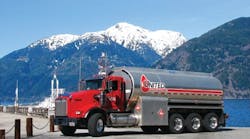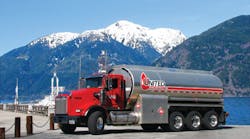WITH customers spread across a large swath of British Columbia, Canada, drivers for United Petroleum Products Inc face some challenging operating conditions. Many trips take them to some of the more remote communities in the province.
The Burnaby, British Columbia-based petroleum hauler has become a specialist at serving these far-flung locations. It is a critical service because the fuel and petroleum products delivered on United Petroleum trucks may be all that keep goods and services moving and homes and businesses warm in some of these areas.
“We supply fuel and other petroleum products to numerous retail locations in some very remote areas,” says Tanya Larsson, United Petroleum's supply and distribution manager. In many circumstances, particularly during the winter, we're the only supplier who can make it through the snowy mountain passes. So, if we weren't able to make our deliveries, it would put many communities through some trying times.”
Olympic experience
The petroleum hauler had a chance to display its service excellence and reliability before an international audience during the 2010 Winter Olympics in Vancouver, British Columbia. The company was selected to supply fuel through its cardlock facility near the ski resort in Whistler, British Columbia, to the Vancouver Olympic Committee, Royal Canadian Mounted Police, and Canadian military.
All of the fuel hauling was done at night, and it was all in the mountains north of Vancouver. United Petroleum's entire tank truck fleet — and more — was devoted to the operation, which lasted six weeks from January into March. Dangerous goods could only be transported at night, and each roundtrip to Whistler took about seven hours.
“We've never before worked within such a tight timeframe or with such strict rules,” Larsson says. “We had to follow a lengthy operating protocol that included speed limits of 30 to 50 kilometers per hour (18 to 31 miles per hour) in some areas and a maximum speed of 80 kilometers per hour (50 miles per hour) on the highway to Whistler.
“Despite the challenges, our support effort for the Vancouver Olympics went smoothly. As a Division of Parkland Industries, we were able to bring in extra equipment from Edmonton (Alberta). We can handle virtually any type of project with the Parkland resources.”
Long history
Part of Parkland Industries since 2007, United Petroleum has been serving British Columbia's Lower Mainland and the interior of the province for more than 40 years. United Petroleum was created by the merger of Christie/Adams Lubricants and Ultra-Fuels Bulk Fuels in 1998.
United Petroleum operations include two c-stores — one in Burnaby and another at Williams Lake — and seven cardlock facilities. The company also has two bulk plants — one with 200,000 liters (52,834 gallons) capacity in Merritt and the other with 150,000 liters (39,625 gallons) capacity in Chilliwack.
The company distributes a broad range of fuels, including the 2% to 5% biodiesel blends that are now mandated across Canada. Also distributed are packaged lubricants from 76 Lubricants, Kendall Motor Oils, Phillips Aviation Lubricants, and Quaker State.
Refined fuels from Chevron, Shell, and Imperial Oil are shipped into United Petroleum's market area by pipeline, barge, and rail (Kamloops, British Columbia only). The United Petroleum fleet hauls out of oil company locations in British Columbia as well as its own bulk plants.
Tank trucks
The fleet consists of 13 tank trucks and truck-and-trailer combinations and four tractors. For the most part, United Petroleum has standardized on Kenworth T800 trucks and tractors. The newest T800s were specified with 525-horsepower Cummins ISX engines, Eaton Fuller 18-speed transmissions, and Eaton drive axles.
“For us, the T800 offers the agility to navigate some tight locations,” Larsson says. “That's important since many of our delivery locations are mom-and-pop stores without a lot of room for our drivers to maneuver a large tanker.”
The T800 comes with a nice cab layout featuring ergonomically placed controls and easy-to-read LED backlit gauges that make nighttime operations easier, according to Larsson. For cab packages, the petroleum hauler selects Kenworth's Diamond interior with rubber floor mats and a higher grade of seat for the driver.
Praise for cab comfort comes from Roger Hewlett, a United Petroleum driver with 33 years of experience driving trucks for the petroleum hauler and other companies. “Driver comfort on Kenworth trucks seems way ahead of the competitors,” he says. “Kenworth mounts the mirror brackets on the cab door post, which helps reduce mirror vibration. The windows and driver positioning in the cab is such that you can see very well.”
The tank trucks have capacities ranging from 16,000 liters (4,200 gallons) to 23,000 liters (6,000 gallons). Pull tank trailers used in the truck-and-trailer combinations hold 30,000 (7,900 gallons) to 35,000 liters (9,200 gallons).
The four tractors are used with a variety of trailers. Packaged lubricants are transported in 43-ft-long three-axle van trailers. Gasoline and diesel are hauled in tri-axle 35,000-liter tankers and in Super B-trains. Tank trailers and truck tanks have four compartments and are supplied by Advance Engineered Products Ltd.
Diverse customers
The fleet serves a diverse customer base, including a growing number of First Nation (native) communities. “We're one of the largest suppliers of fuels and lubricants to the First Nations in British Columbia,” Larsson says. “We started working with the First Nations in 2001, and our involvement with them has grown steadily through word of mouth.”
United Petroleum supplies c-stores, cardlock stations, lube shops, auto dealerships, and automobile and truck repair shops. Fuels and lubricants also are delivered to terminals and docks and companies in the aviation, transportation, construction, forestry, and mining industries.
The company's tank trucks operate in some of the most rugged parts of British Columbia, and drivers spend up to 58% of their times in the mountains. Some trips take all day. United Petroleum's distribution area includes British Columbia's south coast, the Cariboo Mountains, the Kootenays (Nelson and Castlegar), and the Nehemiah Valley west of Williams Lake.
Depending on the route, each truck in the fleet runs 100,000 to 250,000 kilometers (62,000 to 155,000 miles) per year. Some trucks run in a slip-seat operation, with deliveries being made nearly around the clock.
During the winter months, United Petroleum has one truck dedicated to travel up the Sea-to-Sky Highway to Whistler and Pemberton four to five times a week. Whistler has one service station that serves mostly visitors and one cardlock station primarily for local residents and businesses, such as taxicab companies.
Drivers keep the fuel and lubricants moving regardless of weather or other factors. Summers are very busy due to the large numbers of tourists who flock to the region. Winter brings plenty of rain, snow, and ice to complicate driving and delivery operations.
Regardless of the conditions, customers know that United Petroleum's drivers will make their deliveries if at all possible. It's a service commitment that the company and its employees have kept for many decades. ♦











